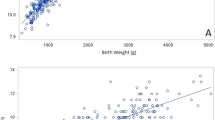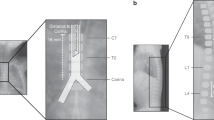Abstract
Objectives
Assess the feasibility of using a disposable pressure transducer with integrated digital display to differentiate arterial versus venous line placement in neonates.
Study design
Infants ≥23 weeks’ gestation with appropriately placed umbilical catheters were enrolled. A single baseline pressure reading was obtained, hypothesizing that arterial placement could be differentiated with a pressure ≥12 mmHg.
Results
Forty-five infants were enrolled to obtain 62 measurements, 31 from both umbilical artery catheters(UAC) and umbilical venous catheters(UVC). 100% of UAC were ≥12 mmHg and 87% of UVC were <12 mmHg. Median device pressures for UAC and UVC were 41 mmHg (IQR 31–45 mmHg) and 5 mmHg (IQR 3–9 mmHg) (p-value < 0.0001). An optimal venous device pressure cut point was determined to be 21 mmHG (97% sensitivity, 100% specificity, AUC 0.98).
Conclusion
This transducer is likely safe and can differentiate line placement in arterial and venous systems. 12 mmHg appears to reliably identify lines placed in the arterial system, but 21 mmHG was found to be the optimal venous cut point.
This is a preview of subscription content, access via your institution
Access options
Subscribe to this journal
Receive 12 print issues and online access
$259.00 per year
only $21.58 per issue
Buy this article
- Purchase on SpringerLink
- Instant access to full article PDF
Prices may be subject to local taxes which are calculated during checkout






Similar content being viewed by others
Data availability
The datasets and materials analyzed for this study are available through contact with the corresponding author.
References
Togashi K, Nandate K, Hoaglan C, Sherman B, Bowdle A. A multicenter evaluation of a compact, sterile, single-use pressure transducer for central venous catheter placement. Anesth Analg. 2013;116:1018–23.
Alonzo CJ, Nagraj VP, Zschaebitz JV, Lake DE, Moorman JR, Spaeder MC. Blood pressure ranges via non-invasive and invasive monitoring techniques in premature neonates using high resolution physiologic data. J Neonatal Perinat Med. 2020;13:351–8.
Pejovic B, Peco-Antic A, Marinkovic-Eric J. Blood pressure in non-critically ill preterm and full-term neonates. Pediatr Nephrol J Int Pediatr Nephrol Assoc. 2007;22:249–57.
Lisa Bergersen ACM, Foerster S, Meadows J. Hemodynamics. In: Lisa Bergersen ACM, Foerster S, Meadows J, editor. Congential heart disease. Boston, MA: Springer; 2009.
Jain A, McNamara PJ, Ng E, El-Khuffash A. The use of targeted neonatal echocardiography to confirm placement of peripherally inserted central catheters in neonates. Am J Perinatol. 2012;29:101–6.
de Souza TH, Brandão MB, Nadal JAH, Nogueira RJN. Ultrasound guidance for pediatric central venous catheterization: a meta-analysis. Pediatrics. 2018;142:e20181719.
Johnson KN, Thomas T, Grove J, Jarboe MD. Insertion of peripherally inserted central catheters in neonates less than 1.5 kg using ultrasound guidance. Pediatr Surg Int. 2016;32:1053–7.
Hammon RA, Seuss H, Hammon M, Grillhösl C, Heiss R, Zeilinger M, et al. Improved visualization of peripherally inserted central catheters on chest radiographs of neonates using fractional multiscale image processing. BMC Med imaging. 2019;19:3.
Acknowledgements
I would like to extend a thank you to Danielle Brooks for her clinical expertise and to Yana Feygin and Mst Sharmin Akter Sumy for providing statistical support for this project. I would also like to thank Roger Soll, MD for his help with the study design and review of the manuscript.
Funding
Norton Healthcare provided funding for this project by purchasing the 62 disposable pressure transducers.
Author information
Authors and Affiliations
Contributions
Carrie Moore helped to design this project and wrote the manuscript. Keri Marques helped to design this project and edited the manuscript. Lori Devlin, Cynthia Crabtree, Amanda Farris, and Joshua Kurtz helped with project design and edited the manuscript
Corresponding author
Ethics declarations
Competing interests
The authors declare no competing interests.
Ethics approval and consent to participate
This project was approved by the University of Louisville Institutional Review Board (IRB# 21.0848) and the Norton Healthcare Research Office (RO# 22-N0047) and informed consent was obtained from the legal guardians prior to the initiation of all study procedures. All methods were performed in accordance with the relevant guidelines and regulations.
Additional information
Publisher’s note Springer Nature remains neutral with regard to jurisdictional claims in published maps and institutional affiliations.
Rights and permissions
Springer Nature or its licensor (e.g. a society or other partner) holds exclusive rights to this article under a publishing agreement with the author(s) or other rightsholder(s); author self-archiving of the accepted manuscript version of this article is solely governed by the terms of such publishing agreement and applicable law.
About this article
Cite this article
Moore, C., Devlin, L.A., Crabtree, C. et al. Disposable pressure transducer to identify central pressure measurements in umbilical lines for preterm and term infants in the neonatal intensive care unit. J Perinatol 45, 1389–1394 (2025). https://doi.org/10.1038/s41372-025-02338-6
Received:
Revised:
Accepted:
Published:
Issue date:
DOI: https://doi.org/10.1038/s41372-025-02338-6



